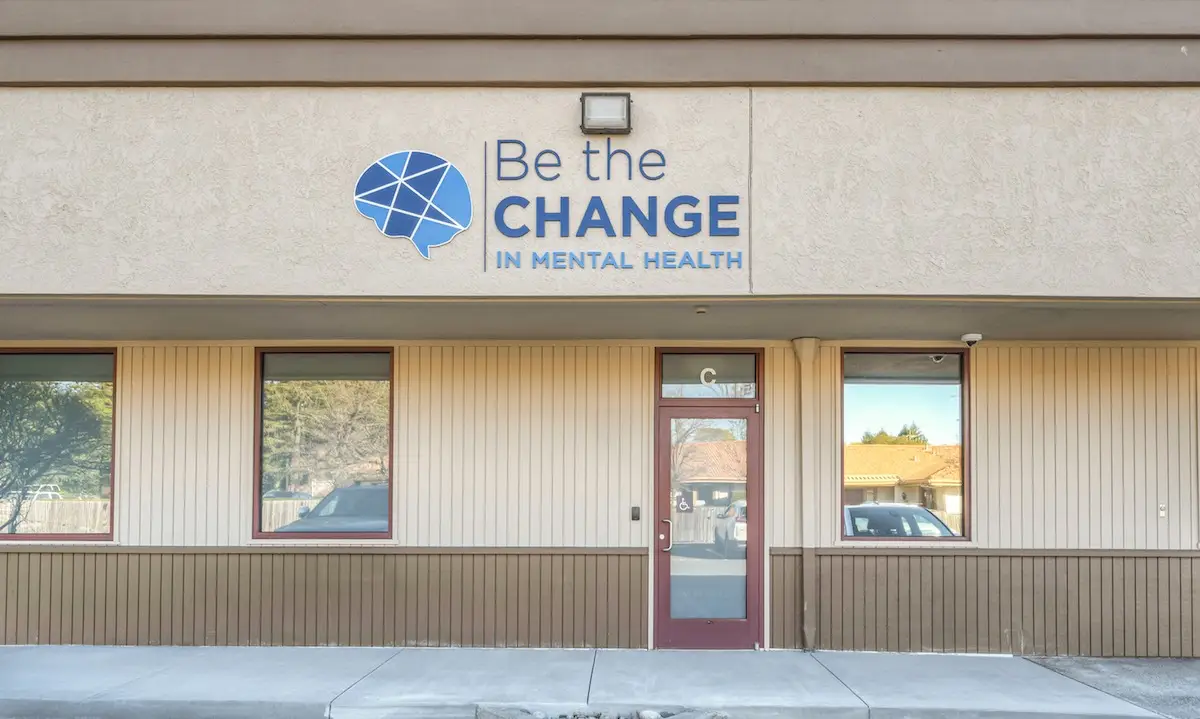Photo by Riccardo from Pexels
Partner Content
“You don’t have to be sick to want to be more well” is the fundamental approach at Be The Change in Mental Health (BTC) — a new kind of wellness clinic in Santa Rosa offering a revolutionary approach to mental wellness. Compelled to be part of a solution in our country’s mental health crisis, Dr. Marisha Chilcott, MD, and her team opened the doors this month.
As a practicing family physician, hospitalist and aesthetics medicine specialist, Chilcott has stayed on the pulse of healthcare throughout her career, which includes two locations of Morpheus Medical Aesthetics in the Bay Area. However, after listening to an interview with Rick Doblin, Ph.D., who has dedicated his entire life to making MDMA a legal medication for the treatment of trauma, she knew she wanted to make this incredibly effective protocol available to anyone (regardless of ability to pay). BTC currently offers the breakthrough technology of Transcranial Magnetic Stimulation (TMS) to treat patients with depression who do not want to take medications at all, as well as Ketamine Assisted Psychotherapy (KAP).
Photo 1: BTC Director of Operations Michelle Crippen with Dr. Marisha Chilcott
Photo 2: BTC team
Q&A with BTC founder, Dr. Marisha Chilcott
Why a mental health clinic?
I want to carry the baton from legalization to widespread treatment availability through the establishment of scalable clinics that treat both people who are seeking relief from the disease states of severe depression, anxiety, and PTSD, and people who are reasonably mentally healthy, that are interested in being even better. Although traditional psychotherapy is always recommended to help patients find insights into the sources of the wounds and traumas that may have initiated their depression, it is not a requirement to achieve improvement. We aim to provide the treatments that have been proven to achieve improvement. BTC in Santa Rosa is just the beginning!
What is the most important message you want to share with potential patients?
At BTC, we feel the fundamental problem with our “healthcare system” in the U.S. is that it is actually a sick treatment system that has little to do with health, other than the idea that the reduction of pathology is the primary measure of success. Why do we think that less bad is good enough? This is evident in every element of the practice of allopathic medicine, but our society is bumping up against a burgeoning desire to at least be a little more mentally healthy!
There is an increasing number of people seeking ways to be better than they currently are, even if they are not severely depressed. Managing and doing “OK” on daily Zoloft or Wellbutrin, just does not seem good enough to me. We want to be feeling fantastic, and alive, and well, not just slogging through the days managing, perhaps barely. As a society, we have new gratitude practices. We hire life coaches. We listen to Tara Brach on podcasts. And we are exploring psychedelic medicines in the jungles of Costa Rica, the living rooms of underground “guides,” and getting high on ketamine we get through an app? At BTC, we provide a professional setting so people can feel their best inside and out.
So a person doesn’t have to have an official diagnosis of psychiatric disorder to benefit from treatment?
Just like one does not need to be diagnosed as obese to know that it would feel better and be healthier to have less fat around the middle, BTC patients do not have to be diagnosed with mental illness to be mentally healthier. It is true that our treatment modalities are rooted in research on how to help those with diagnoses named in the American Psychiatric Association’s Diagnostic and Statistical Manual of Mental Disorders, “Major Depressive Disorder (MDD)” and “Generalized Anxiety Disorder (GAD).” But most of us have conditions that are not clinical, and it turns out that we, too, can get better than we are now using these treatment tools.
It is our objective to make our treatment options available to all who are truly interested in being more well. We are founded in the belief that mental illness is at the root of most of our social ills and that mental health is the route through which we will all have better lives. If you are more mentally healthy, I, and everyone that you encounter in your entire life, will be better for it. There is a multiplicative effect of both dis-ease and wellness that can be neither calculated nor safely disregarded.
Which treatments are you most excited about?
Ketamine-assisted Psychotherapy (KAP) and transcranial magnetic stimulation (TMS) are at two ends of the spectrum of treatments for depression and anxiety, conditions that both Big Pharma and chronic talk therapy have failed to really cure. Albeit, they can each/both make psychopathological conditions somewhat better.
KAP is a short course of intensive psychotherapy that requires the patient to engage with their issues and rewrite the narrative with the assistance of both a professional therapist and a medication that severs the “self” from the human for a brief period of time. Ketamine is more of a psycholytic than a psychedelic. It does not make you hallucinate so much as make you aware that the you that is you, is neither your body nor your human being, but rather a spirit, having a human experience.
In contrast, TMS is a completely drug-free, passive treatment that addresses the bioelectrical nature of depression as a condition where the left lateral, prefrontal cortex of the brain is observed to have reduced activity. The powerful magnet, carefully positioned after the individual’s brain is “mapped” by the physician, introduces pulses of energy that activate the neuronal tissue on a cyclic basis. Then, after a series of treatments, most people (60%) with major depressive disorder will go into remission and no longer meet criteria for the diagnosis of depression! Remission typically lasts 6-18 months, at which point a patient may want/need a “tune-up” set of treatments.
Ketamine Assisted Psychotherapy vs. Transcranial Magnetic Stimulation*
Ketamine Assisted Psychotherapy (KAP) | Transcranial Magnetic Stimulation (TMS) | |
Involves a Drug | YES | NO |
Requires DIGGING into the Psychology | YES | NO |
Covered by most insurance | NO | YES |
OK in pregnancy/breast feeding | NO | YES |
Acts quickly enough to address suicidality? | MAYBE | UNLIKELY |
* sourced by BTC
Photos: Acutal BTC patient receiving TMS and Michelle Crippen, Dir of Operations, getting to experience having her brain "mapped" with the NeuroStay TMS device
What does insurance cover?
Insurance will not pay for laboratory tests unless you have symptoms marking you as potentially sick. You cannot just check your cholesterol, ferritin, or insulin level to see how you are doing relative to six months ago, unless your doctor writes in the order form some ICD-10 codes that “merit” these tests. You have to have a “problem” to warrant looking at whether or not you are doing better or worse. For instance, insurance will pay for Vitamin D if you are deficient, but you must buy your own supplements if you want to avoid becoming deficient.
If one has the diagnosis of major depressive disorder, and has failed at least four different medications in at least two different classes, most insurance companies will cover the costs of TMS. No insurance companies will currently cover KAP, but some will cover the cost of Spravato Ⓡ(esketamine), a nasal inhaled form of ketamine medication that costs $590-$880 per dose, and some will cover the integrative psychotherapy session itself.
Most health insurance carriers in California (except Medi-Cal), will cover TMS therapy if it is administered every day for 36 days (five days per week for over seven weeks.) Going to a clinic every single day can be a significant barrier to actually getting this treatment. Stanford scientists and others across the country have developed equivalently effective protocols of treatment with TMS that can be delivered in as little as five days total. At BTC we are implementing protocols, extrapolated from Stanford University’s SAINT protocol and those explored by other neuroscientists that include multiple treatments per day one to three times per week, which can make the treatments much more reasonable to fit into a real person’s schedule.
How can you be sure a person needs these treatments?
Someone said to me in protest recently, “But it is unethical to give people medications unless they need them!” To which I retorted, “All I do, all day long, is give people medicine that they want but do not ‘need’! I make my living primarily by injecting Botox into the faces of people who do not want to feel or look stressed-out and angry. In that part of my medical life, no one needs what I do for them, and everyone wants it.”
How do you feel about the government restricting some drugs while allowing others?
First, do no harm, is the Hippocratic Oath every doctor takes before practicing. We are also taught that patients have a right to self-determination. However, the government and our society, in general, are pretty sure that when it comes to several substances, adults cannot be trusted to self administer safe or sane amounts of medications. I agree in some cases. Cocaine, methamphetamine, heroin and several (if not all) opiates and benzodiazepines just feel too good for humans (or any mammals) to self-regulate their use. But we will allow the illusion of self-governance when it comes to tobacco and alcohol.
Have you tried either MDMA, psilocybin mushrooms or Ketamine?
Having been treated for depression with ketamine, I am certain that I never want to take that medication again, unless it is going to benefit me in a material way. It was not horrible, but it was not fun. I would describe the experience of ketamine like shaking the snow globe of your life. A blizzard of new snow blankets your perspective and all is possible. But, you must do the integration therapy to make new tracks in the snow. If you do not do the work, you will inevitably slip back into the hardened tracks that lie beneath the powder and nothing at all will have changed.
I do not have the personal experience to say where MDMA might fall in the spectrum. I am pretty sure that in spite of how enjoyable psilocybin trips may be, most people do not return from them thinking that they want to take mushrooms on a daily basis and stay in that state indefinitely.
How do we distinguish between just giving people drugs to get high and administering medications that will result in a material improvement in their lives?
Ketamine is in fact a controlled substance and it is incumbent on the medical professionals that prescribe it to make sure that those to whom they are administering or prescribing are not abusing, over or inappropriately using, or otherwise potentially harming themselves.
At BTC, our clinicians will assess every potential patient to rule out underlying conditions that may be worsened or exacerbated by the treatments we offer. No one with a history of psychosis, a probability of mania, nor any active methamphetamine use will be allowed to receive ketamine. Everyone will be required to “Do the work!”
Learn more at BTCMentalHealth.org



